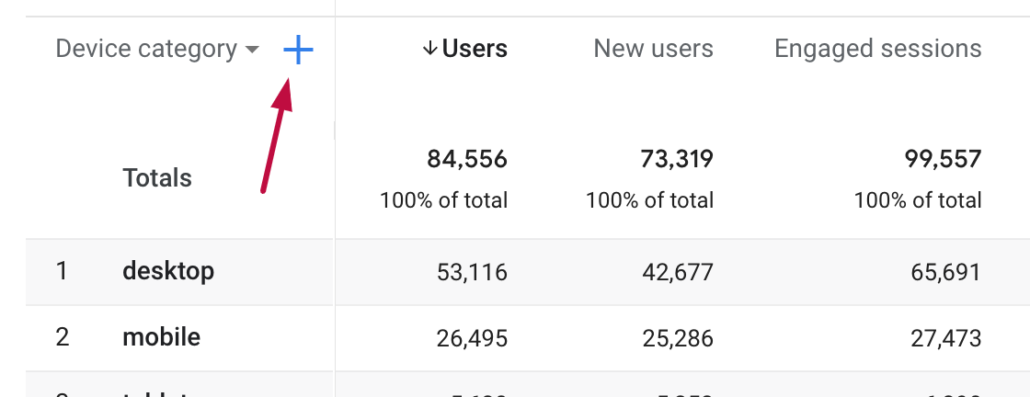Optimizing Search Engine Optimization with Secondary Dimension in Google Analytics
Wiki Article
Unlock Deeper Insights With Second Measurement in Google Analytics
With the large stretch of data available in Google Analytics, the usage of second measurements can substantially enhance your logical abilities. These additional layers of information offer a nuanced perspective that can illuminate intricate information within your key metrics. By strategically including additional dimensions right into your analysis, you can uncover useful insights that may or else stay undiscovered. The capability to analyze and dissect customer behavior with greater precision opens a realm of opportunities for improving and maximizing techniques efficiency.Understanding Primary Vs. Additional Measurements
When assessing data in Google Analytics, it is vital to distinguish between second and primary dimensions to obtain much deeper understandings into user behavior. Primary dimensions are the primary groups by which you can watch your information, such as device, landing, or source/medium web page. These measurements give the fundamental structure for organizing and understanding your data. On the various other hand, second dimensions allow you to further dissect your primary dimension information. By adding a secondary measurement, you can layer on added info to your main measurement, enabling an extra granular evaluation. For instance, if your key measurement is the source/medium whereby individuals showed up on your site, adding an additional measurement like geographic place can reveal where those users lie geographically. When looking at the primary measurement alone, this included layer of information can aid you recognize patterns, patterns, or abnormalities that may not have been obvious. Leveraging both key and second measurements in Google Analytics is important for thorough information analysis and informed decision-making.Utilizing Additional Measurements Successfully
By integrating secondary dimensions along with key dimensions, marketers and analysts can dig deeper into the specifics of customer communications on their internet sites. Additional dimensions allow individuals to segment and filter primary dimension information even more, providing a more detailed view of user demographics, behaviors, and communications.Additionally, second dimensions enable users to contrast and contrast various data factors within a single record, helping with a much more comprehensive analysis of individual behavior patterns. By leveraging additional measurements successfully, companies can discover surprise insights, enhance their advertising strategies, and improve the total user experience on their web sites.
Discovering Common Additional Measurement Mixes
To better evaluate customer habits and trends in Google Analytics, it is important to discover usual mixes of secondary measurements. By incorporating various secondary dimensions, online marketers and analysts can gain deeper understandings right into just how various aspects interact and impact internet site performance. Some common secondary dimension combinations that offer useful understandings consist of examining website traffic resources with customer places to comprehend where website site visitors are coming from geographically and exactly how they discovered the site. Integrating landing pages with gadgets can reveal which web pages do best on different devices, helping in enhancing the web site for better customer experience. Examining individual habits metrics with secondary dimensions such as passions or demographics can assist in targeting specific target market segments more effectively. By discovering these typical secondary dimension mixes, this companies can reveal covert patterns, recognize chances for renovation, and make data-driven decisions to improve their on-line presence.Using Second Dimension in Custom Information
Using second dimensions in personalized records permits an extra detailed analysis of data in Google Analytics, improving the depth of understandings acquired. When developing customized records in Google Analytics, incorporating secondary dimensions can provide a much more thorough sight of just how various dimensions communicate with each other. This feature enables users to delve deeper right into their information and reveal valuable correlations that might not be right away noticeable.By using additional dimensions in custom reports, customers can obtain a better understanding of their website or app traffic. Incorporating the key dimension of "source/medium" with the second measurement of "landing web page" can expose which landing web pages are carrying out finest for web traffic coming from certain sources. This understanding can help online marketers enhance their campaigns and boost general conversion prices.
Learn More Here

Enhancing Data Visualization With Second Measurement
When checking out information in Google Analytics custom records, including additional dimensions not just gives an extra comprehensive evaluation yet likewise improves the graph of insights via information visualization. By adding an additional dimension to your reports, you can enhance the means information is presented, making it less complicated to identify patterns, fads, and connections within your web site's efficiency metrics.Second dimensions can help you segment your data better, permitting for a deeper understanding of customer actions and interactions on your website. This improved degree of granularity can be particularly beneficial when attempting to isolate particular variables that may impact your web site's efficiency - Secondary Dimension in Google Analytics.

Verdict
In final thought, leveraging additional dimensions in Google Analytics enables an extra thorough evaluation of information, resulting in much deeper insights and even more informed decision-making. Secondary Dimension in Google Analytics. By adding linked here extra layers of info to primary information sets, online marketers and experts can reveal hidden fads, patterns, and correlations that give a granular view of user habits and interactions. This improved level of understanding makes it possible for optimization of campaigns and customized methods for details audience sectors, eventually improving efficiency and conversion pricesOn the various other hand, additional dimensions allow you to more explore your key measurement data. By including an additional measurement, you can layer on additional info to your key measurement, making it possible for a more granular analysis. If your main measurement is the source/medium via which customers arrived on your site, adding a secondary measurement like geographical area can expose where those customers are located geographically. By incorporating second measurements together with main measurements, analysts and online marketers can dive much deeper right into the specifics of customer communications on their sites. Secondary dimensions enable customers to sector and filter key measurement information further, providing a much more in-depth sight of customer actions, communications, and demographics.
Report this wiki page